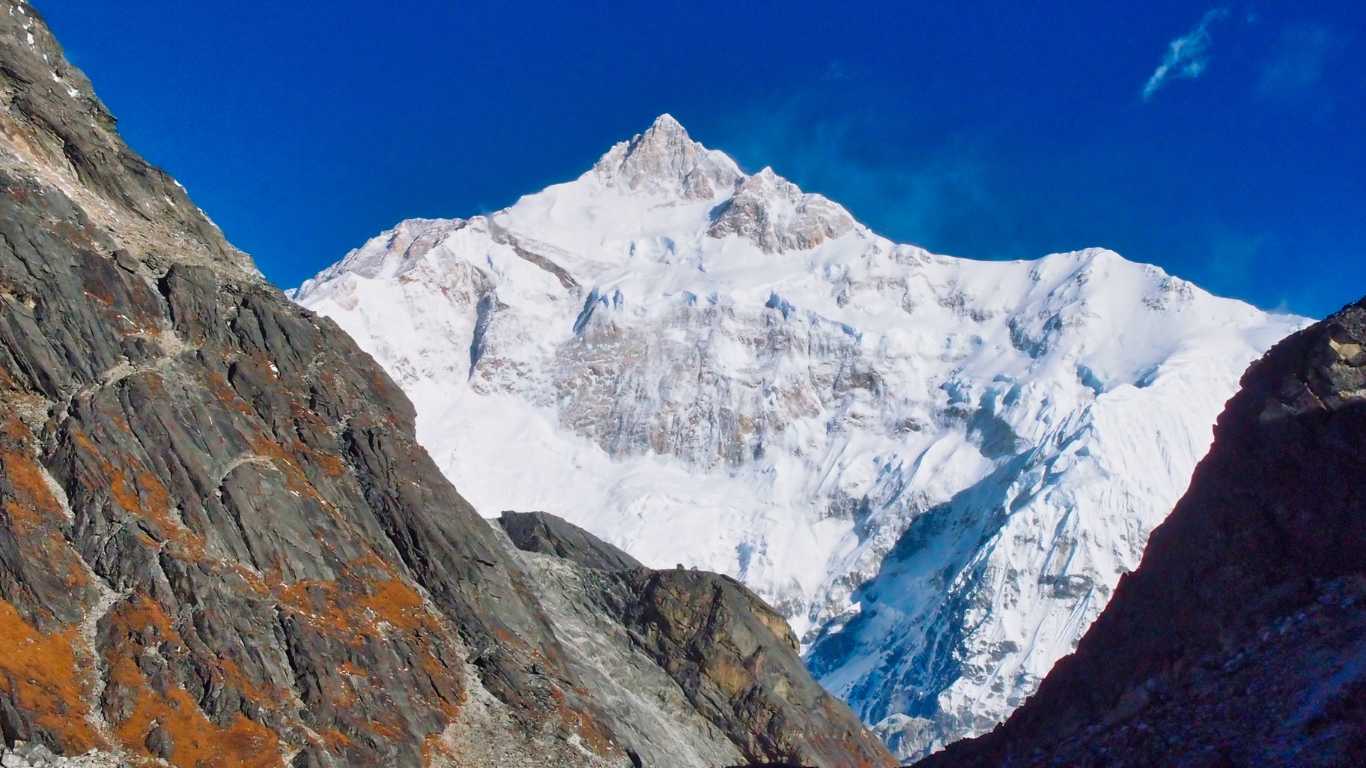Nestled in the northeastern part of India, Sikkim stands as a pristine Himalayan treasure, inviting intrepid adventurers to explore its rugged landscapes and immerse themselves in a unique blend of cultural diversity. This Himalayan state is renowned for its dramatic mountain vistas, dense forests, and tapestry of diverse cultures, making it an exceptional trekking destination. With towering peaks like Kanchenjunga and a network of ancient trails, Sikkim offers a range of trekking experiences, from serene nature walks to challenging high-altitude adventures. This guide will unlock the secrets of trekking in Sikkim, providing insights into its top destinations, preparation, cultural richness, and much more.
Best Time to Trek in Sikkim
Sikkim’s breathtaking landscapes, with their snow-capped peaks, lush forests, and pristine lakes, beckon trekkers year-round. However, the best time to trek in this Himalayan wonderland depends on your preferences, the trekking route, and the weather conditions you are comfortable with. Here’s a breakdown of the best times to trek in Sikkim:
1. Spring (March to May):
- Highlights: Spring is a magical time in Sikkim when the rhododendrons are in full bloom, painting the hills in vibrant hues.
- Trekking Routes: Goechala Trek, Dzongri Trek, Kanchenjunga Base Camp Trek.
- Weather: Pleasant daytime temperatures, clear skies, and blooming landscapes make it an ideal season for most treks.
2. Summer (June to September):
- Highlights: Summer in Sikkim offers lush greenery, but it’s also the monsoon season, so prepare for rain.
- Trekking Routes: Dzongri Trek, Singalila Ridge Trek.
- Weather: Rainfall is frequent, and trails can be slippery. Leeches are also common. Not recommended for high-altitude treks.
3. Autumn (October to November):
- Highlights: Crisp, clear skies, and post-monsoon greenery create a stunning backdrop for trekking.
- Trekking Routes: Goechala Trek, Singalila Ridge Trek.
- Weather: Cool and dry weather, making it one of the best times for trekking. Excellent visibility for mountain views.
4. Winter (December to February):
- Highlights: Sikkim in winter offers a unique charm, with snow-covered landscapes and fewer tourists.
- Trekking Routes: Dzongri Trek (until late December), shorter treks at lower altitudes.
- Weather: Extremely cold, especially at higher altitudes. Snow and ice can make trails challenging. Only recommended for experienced trekkers.
5. Pre-Monsoon (Late February):
- Highlights: Just before the monsoon season, this brief window offers a mix of winter’s tranquility and the approaching spring.
- Trekking Routes: Dzongri Trek (late February), shorter treks.
- Weather: Cold but not as severe as mid-winter. Snow starts melting, and trails become accessible.
The best time for your Sikkim trek depends on your preferences. If you seek vibrant flora, spring is ideal. For clear skies and post-monsoon freshness, choose autumn. Adventurous winter treks are for those who can handle the cold, while pre-monsoon offers a unique blend of seasons. Keep in mind that weather conditions can be unpredictable in the mountains, so always check local forecasts and trail conditions before embarking on your trek.
Why Go Trekking In Sikkim?
Trekking in Sikkim offers a myriad of compelling reasons to explore this Himalayan paradise:
- Breathtaking Scenery: Sikkim boasts some of the world’s most stunning landscapes, including towering peaks like Kanchenjunga, lush alpine meadows, pristine lakes, and dense forests. The panoramic vistas and diverse terrain make it a visual delight for nature enthusiasts and photographers.
- Rich Biodiversity: Sikkim is renowned for its diverse flora and fauna. Trekking allows you to immerse yourself in this biodiversity, with opportunities to spot rare species like the Red Panda, various orchids, and a wide array of birdlife.
- Cultural Immersion: Sikkim’s cultural diversity is as captivating as its natural beauty. Trekking routes take you through remote villages inhabited by different ethnic groups like the Bhutias, Lepchas, and Nepalis. Interacting with these communities offers insights into their traditions, customs, and way of life.
- Peaceful and Serene: Trekking in Sikkim offers a retreat from the chaos of city life. The serene landscapes, tranquil lakes, and quiet trails provide a sense of peace and solitude that’s hard to find elsewhere.
- Challenging Adventures: Whether you’re an experienced trekker seeking high-altitude challenges or a beginner looking for moderate routes, Sikkim has trekking options for everyone. The rugged terrain and steep ascents make it an adventure seeker’s paradise.
- Cultural and Spiritual Sites: Sikkim is dotted with monasteries, temples, and sacred sites. Trekking often includes visits to these places, allowing you to explore the spiritual and cultural aspects of the region.
- Seasonal Variations: Sikkim offers different experiences throughout the year. Spring brings rhododendron blooms, while autumn offers clear skies and stunning mountain views. Each season offers its unique charm.
- Local Cuisine: Sikkimese cuisine is a delightful blend of flavors influenced by Tibetan, Nepali, and Bhutia cultures. Trekking allows you to savor local delicacies like momos, thukpa, and more.
- Adventure Hub: Sikkim serves as a gateway to various high-altitude treks, including the Goechala Trek and Kanchenjunga Base Camp Trek, making it an ideal starting point for seasoned trekkers.
- Sustainable Tourism: Sikkim places a strong emphasis on eco-friendly and sustainable tourism practices, ensuring that your trek has a minimal impact on the environment.
Trekking in Sikkim offers a blend of natural beauty, cultural diversity, adventure, and tranquility that few places can match. It’s an opportunity to disconnect from the hustle and bustle of daily life and reconnect with the splendor of the Himalayas and the warmth of its people.
Top Trekking Destinations in Sikkim
Nestled in the Himalayas, Sikkim offers a treasure trove of trekking experiences. From the awe-inspiring Kanchenjunga Base Camp to the lush rhododendron forests of Goechala, these top destinations promise adventure, natural beauty, and encounters with diverse cultures. This guide will unveil the finest trekking spots in Sikkim, each with its own unique charm, challenging trails, and breathtaking vistas. Get ready to embark on a Himalayan journey like no other.
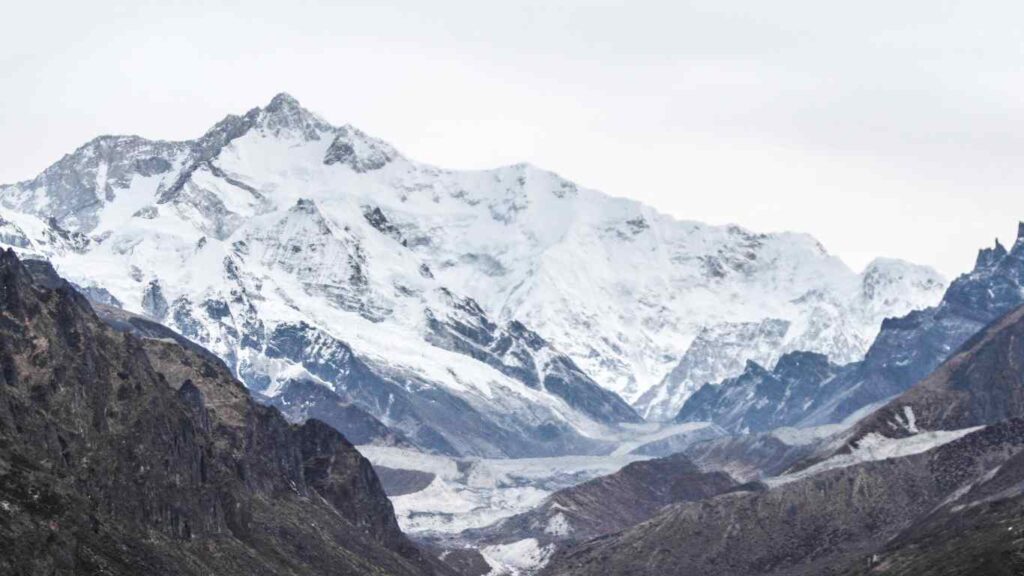
Goechala Trek
The Goechala Trek is a pilgrimage for nature enthusiasts and adventure seekers alike, nestled in the heart of Sikkim’s pristine landscapes. Offering a mesmerizing blend of dense forests, alpine meadows, and jaw-dropping views of the world’s third-highest peak, Mount Kanchenjunga, this trek ranks among Sikkim’s most sought-after experiences.
Highlights:
- Kanchenjunga Vista: Goechala presents a front-row seat to the majestic Kanchenjunga, and if you’re lucky, you might catch glimpses of other Himalayan giants like Pandim, Kabru, and Rathong.
- Flora and Fauna: Traverse through enchanting rhododendron forests, home to diverse flora and fauna, including the elusive Red Panda, making it a paradise for nature lovers.
- Cultural Immersion: Interact with the warm-hearted locals, predominantly of Tibetan descent, and immerse yourself in their unique culture and traditions.
- Challenging Terrain: The trek is challenging, demanding both physical endurance and mental fortitude. However, the sense of achievement upon reaching Goechala Pass is unparalleled.
- Photographer’s Dream: Every step of this journey is a photo opportunity. Capture the play of light and shadow on the Himalayan peaks, pristine lakes, and vibrant landscapes.
Difficulty Level: The Goechala Trek is considered moderately difficult. Trekkers should be in good physical condition, as the trail includes steep ascents and descents, river crossings, and the challenge of high altitudes.
Ideal Duration: The trek typically spans 8 to 10 days, allowing trekkers to acclimatize to the altitude gradually.
Permits and Regulations: All trekkers must obtain permits from the Sikkim Tourism Department and should ideally be accompanied by licensed local guides to ensure safety and compliance with environmental regulations.
Best Time to Trek: The best time to embark on the Goechala Trek is during the spring (March to May) and autumn (October to November), when the weather is pleasant, and the views are at their best.
Recommended Itineraries: Several itineraries cater to different preferences and fitness levels. A popular option is to begin the trek from Yuksom and return via the same route, or continue towards Dzongri and descend to Tshoka for a circular trek.
The Goechala Trek promises an unforgettable journey through the Himalayas, offering trekkers a chance to witness the natural grandeur of Sikkim and forge lasting memories amidst one of the world’s most spectacular mountain ranges.
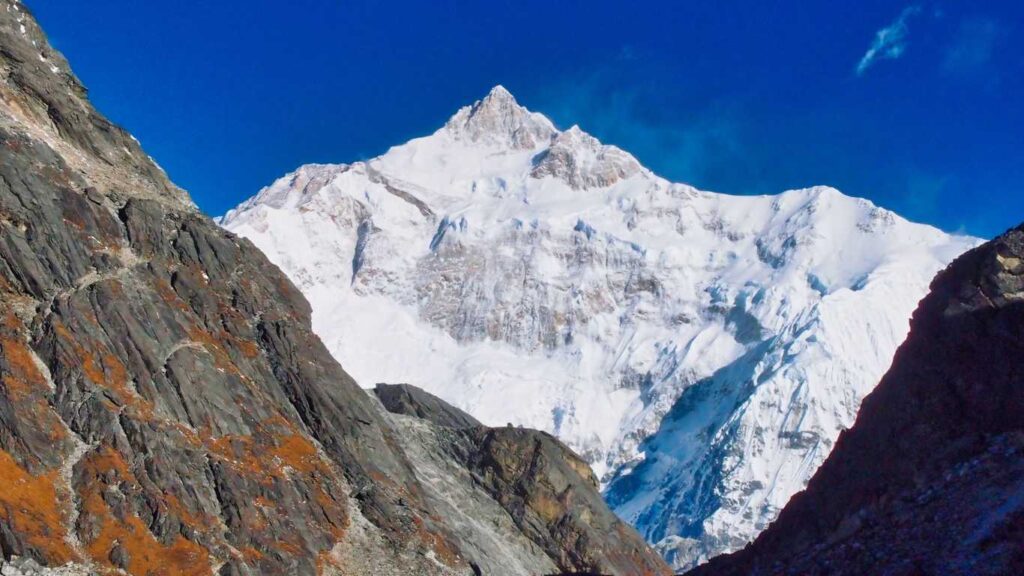
Kanchenjunga Base Camp Trek
The Kanchenjunga Base Camp Trek, named after the towering Kanchenjunga, the world’s third-highest mountain, is a testament to Sikkim’s unspoiled beauty and challenging terrain. This epic journey takes trekkers deep into the lap of the Himalayas, providing an immersive experience in nature’s grandeur and a close encounter with the legends of the Eastern Himalayas.
Highlights:
- Kanchenjunga Majesty: Standing at 8,586 meters, Kanchenjunga’s presence looms large throughout the trek, revealing different facets of its beauty from various vantage points.
- Remote Wilderness: Traverse through remote and pristine landscapes, passing through lush rhododendron forests, terraced fields, and traditional Sikkimese villages, experiencing the local way of life.
- Cultural Encounters: Engage with the friendly indigenous communities, including the Limbus and Sherpas, to gain insights into their age-old traditions and practices.
- Challenging Terrain: The trek offers both physical challenges and rewards, from steep ascents and descents to high-altitude camping, making it a true adventure seeker’s paradise.
- Biodiversity: Explore the region’s rich biodiversity, with opportunities to spot exotic wildlife like the elusive Red Panda and various species of birds and flora.
Difficulty Level: The Kanchenjunga Base Camp Trek is considered strenuous, demanding strong physical fitness and acclimatization due to its high-altitude sections.
Ideal Duration: This trek typically spans around 20 to 25 days, allowing trekkers ample time for acclimatization and exploration.
Permits and Regulations: Trekkers must obtain permits from the Sikkim Tourism Department, and it’s advisable to hire experienced guides and porters to ensure safety and compliance with local regulations.
Best Time to Trek: The ideal time for the Kanchenjunga Base Camp Trek is during the pre-monsoon (April to May) and post-monsoon (September to November) periods when the weather is most favorable for trekking.
Recommended Itineraries: Several itineraries cater to different preferences and fitness levels. Most trekkers begin the journey from Yuksom and follow the Yambong route, offering a circular trek experience.
The Kanchenjunga Base Camp Trek is a soul-stirring expedition that unveils the pristine beauty of Sikkim’s wilderness, offering trekkers a chance to stand in awe of Kanchenjunga’s grandeur and immerse themselves in the rich tapestry of culture and nature that defines this region. It’s an adventure of a lifetime for those willing to embark on this Himalayan odyssey.
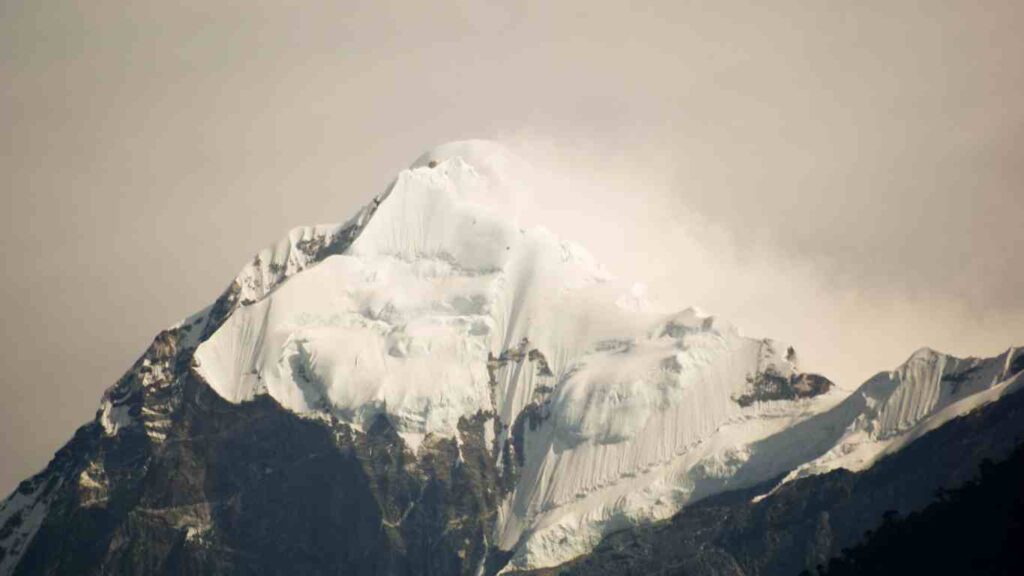
Dzongri Trek
The Dzongri Trek, nestled in the heart of Sikkim’s stunning landscapes, is a captivating journey that introduces trekkers to the pristine beauty and rugged charm of the Himalayas. This trek is renowned for its panoramic vistas of towering peaks, serene alpine meadows, and a unique opportunity to witness the play of light on the mountains.
Highlights:
- Dzongri Viewpoint: Ascend to the Dzongri viewpoint for breathtaking panoramas of Kanchenjunga, Pandim, and other neighboring peaks bathed in the golden hues of sunrise.
- Rhododendron Sanctuaries: Traverse through enchanting rhododendron forests that burst into vivid blooms during the spring, creating a surreal atmosphere.
- Cultural Insights: Encounter the welcoming locals, primarily of Tibetan and Bhutia descent, and gain insights into their culture, traditions, and lifestyle.
- Challenging Terrain: While less strenuous than some treks, the Dzongri Trek still presents a series of steep ascents and descents, ensuring an exciting challenge.
- Unique Biodiversity: Explore the diverse ecosystem of Sikkim, with opportunities to spot rare species like the Red Panda, diverse birdlife, and colorful flora.
Difficulty Level: The Dzongri Trek is considered moderate in difficulty, making it accessible to trekkers with a reasonable level of fitness and prior trekking experience.
Ideal Duration: Typically, this trek spans 8 to 10 days, allowing trekkers to acclimatize gradually and savor the surroundings.
Permits and Regulations: Trekkers are required to obtain permits from the Sikkim Tourism Department. It’s recommended to hire local guides to ensure adherence to environmental regulations and for safety.
Best Time to Trek: The best times for the Dzongri Trek are spring (March to May) and autumn (October to November), when the weather is favorable, and the landscapes are at their most stunning.
Recommended Itineraries: The most common starting point for this trek is Yuksom, and the standard route includes stops at Sachen, Tshoka, and Dzongri. Variations, such as the Dzongri-Goechala combination trek, are also popular among experienced trekkers.
The Dzongri Trek is a gateway to Himalayan magic, offering an unforgettable experience in Sikkim’s wilderness. Whether you’re captivated by the allure of towering peaks or seeking cultural enrichment through interactions with the locals, this trek promises a blend of adventure, nature, and culture that will stay with you long after you’ve left the mountains behind.
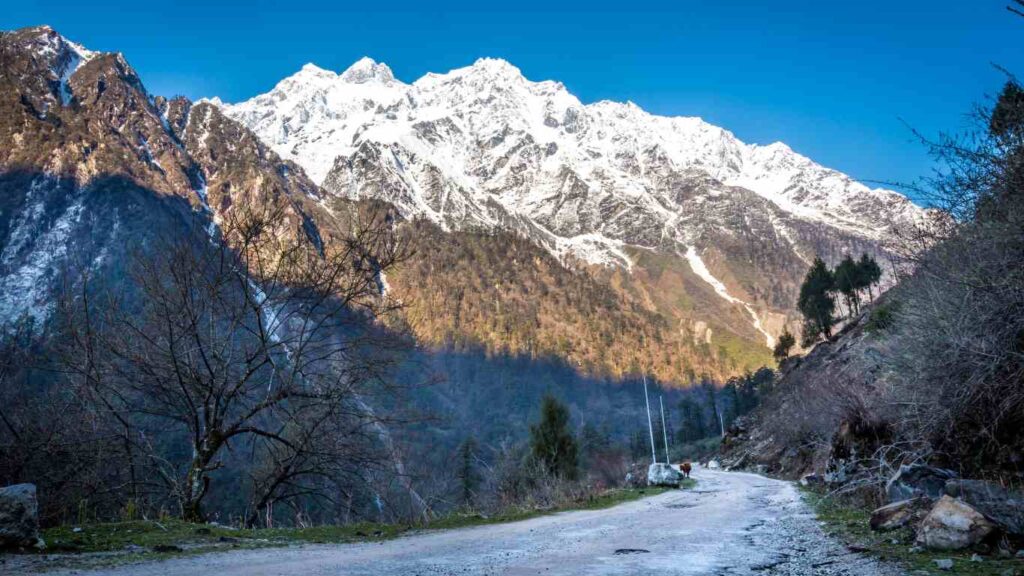
Singalila Ridge Trek
The Singalila Ridge Trek, an enchanting Himalayan adventure, takes trekkers on a scenic journey along the border of India and Nepal. This high-altitude trek offers breathtaking vistas of some of the world’s highest peaks, including Mount Everest and Kanchenjunga, along with a chance to experience the cultural tapestry of the region.
Highlights:
- Panoramic Mountain Views: The Singalila Ridge offers uninterrupted vistas of iconic peaks like Mount Everest, Lhotse, Makalu, and Kanchenjunga, making it a paradise for mountain enthusiasts and photographers.
- Biodiversity: Traverse through rhododendron forests and alpine meadows teeming with diverse flora and fauna, including the elusive Red Panda and various bird species.
- Cultural Encounters: Interact with the local Sherpa and Rai communities, gaining insights into their rich traditions and lifestyles.
- High-Altitude Lakes: Visit pristine high-altitude lakes like Gauri Kund and Kalapokhri, adding a touch of serenity to your trek.
- Challenging Terrain: The trek presents challenging ascents and descents, particularly when crossing high passes like Phalut and Sandakphu, ensuring a thrilling adventure.
Difficulty Level: The Singalila Ridge Trek is moderately challenging, suitable for trekkers with a reasonable level of fitness and some prior trekking experience. The high-altitude sections require acclimatization.
Ideal Duration: This trek typically spans 8 to 10 days, allowing trekkers to acclimatize gradually while exploring the stunning landscapes.
Permits and Regulations: Trekkers are required to obtain permits from the relevant authorities in Sikkim and Darjeeling. Hiring local guides is advisable for safety and compliance with regulations.
Best Time to Trek: The prime trekking seasons for the Singalila Ridge are spring (March to May) and autumn (October to November), when the weather is clear, and mountain views are at their best.
Recommended Itineraries: The trek often begins from Mane Bhanjang or Darjeeling and proceeds through Sandakphu and Phalut, with various detours possible. Many trekkers choose to extend their journey by connecting to trails like the Goechala Trek or descending into Nepal.
The Singalila Ridge Trek promises a once-in-a-lifetime experience, with its stunning mountain panoramas, diverse ecosystems, and cultural interactions. Whether you seek the thrill of high-altitude adventures or a tranquil communion with nature, this trek showcases the Himalayas in all their glory and offers a deeper connection to the lands and cultures they embrace.
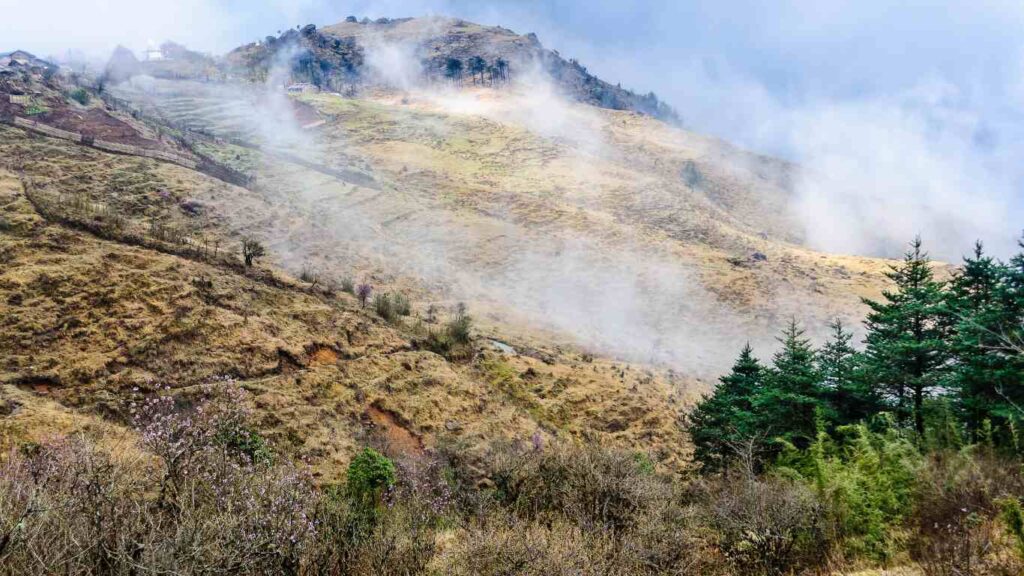
Sandakphu Trek
The Sandakphu Trek, perched at the doorstep of the Himalayas, is a trekker’s paradise, offering a spellbinding journey into the heart of the Eastern Himalayas. Renowned for its breathtaking vistas and diverse landscapes, this trek leads adventurers to the vantage point of Sandakphu, where one can witness the world’s tallest peaks in all their glory.
Highlights:
- Panoramic Views: From Sandakphu, embrace a 360-degree view of the Himalayan range, including four of the world’s tallest peaks—Mount Everest, Lhotse, Makalu, and Kanchenjunga—all in a single glance.
- Rhododendron Wonderland: Traverse through lush rhododendron forests, ablaze with vibrant colors during spring, creating a surreal atmosphere.
- Cultural Immersion: Encounter the charming Gorkha and Sherpa communities en route, gaining insight into their traditional way of life, culture, and cuisine.
- Varied Terrain: The trek presents a mix of terrains, from gentle walks through quaint villages to challenging ascents and descents, ensuring a thrilling adventure.
- Unique Flora and Fauna: Keep an eye out for the elusive Red Panda, numerous bird species, and diverse alpine flora, making this trek a nature lover’s delight.
Difficulty Level: The Sandakphu Trek is considered moderate in difficulty, making it suitable for trekkers with a moderate level of fitness and even those new to trekking.
Ideal Duration: Typically spanning 6 to 8 days, this trek allows trekkers to adjust to the altitude and soak in the stunning surroundings.
Permits and Regulations: Obtaining permits is necessary, and hiring local guides is advisable for safety, guidance, and to support responsible trekking practices.
Best Time to Trek: The best times for the Sandakphu Trek are spring (March to May) and autumn (October to November) when the skies are clear, the weather is pleasant, and the landscapes are at their most vibrant.
Recommended Itineraries: The trek traditionally commences from Manebhanjan, traversing through scenic spots like Tonglu, Tumling, and Kalipokhri before reaching Sandakphu. The return journey often includes a stop at Phalut, offering more panoramic views.
The Sandakphu Trek is not just a trek; it’s a journey into the heart of the Himalayas. Whether you’re a seasoned trekker or a novice, this trek offers an unparalleled opportunity to experience the grandeur of the world’s highest mountains, explore diverse landscapes, and immerse yourself in the rich culture of the region. It’s an adventure that promises memories and vistas that will remain etched in your heart forever.
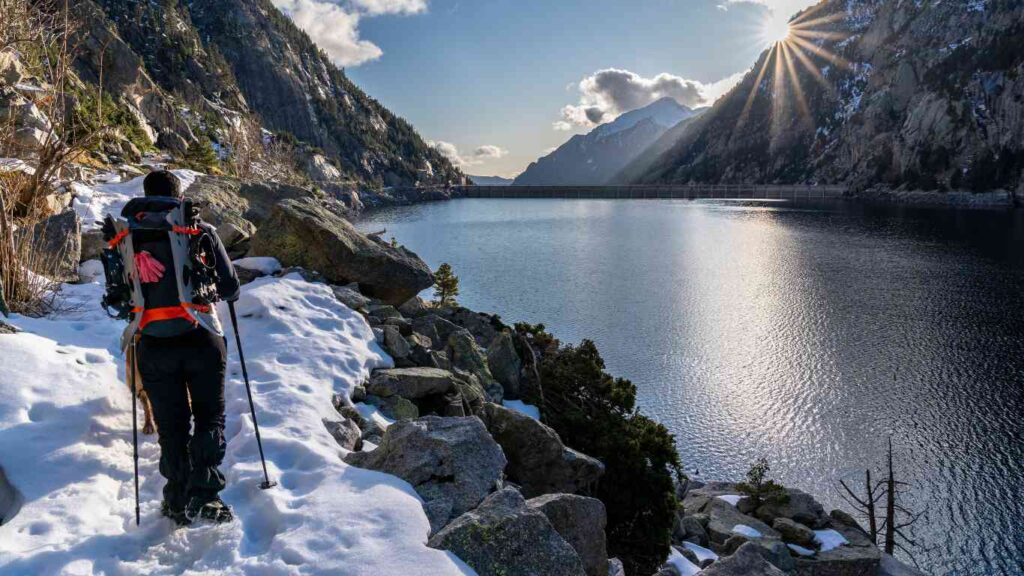
Tosar Lake Trek
The Tosar Lake Trek is a hidden gem in the Himalayan paradise of Sikkim. Nestled at a high altitude, this trek offers intrepid adventurers the chance to explore remote landscapes, pristine alpine meadows, and the enchanting Tosar Lake, all while basking in the awe-inspiring grandeur of the Eastern Himalayas.
Highlights:
- Tosar Lake: The trek’s centerpiece, Tosar Lake, is a serene alpine lake surrounded by towering peaks, providing a picture-perfect setting for camping and reflection.
- High-Altitude Adventure: Ascend to elevations above 4,000 meters, challenging your trekking skills and providing breathtaking views of the Himalayan panorama.
- Unique Flora and Fauna: Encounter the Himalayan wilderness, with opportunities to spot exotic wildlife, including the Red Panda, and explore the unique alpine flora.
- Cultural Encounters: Pass through remote mountain villages and engage with the warm-hearted locals, learning about their traditions, lifestyle, and rich culture.
- Rugged Terrain: The trek includes a mix of terrains, from steep ascents to rocky trails, offering an exhilarating and challenging adventure.
Difficulty Level: The Tosar Lake Trek is considered moderately challenging, suitable for trekkers with prior experience and a good level of fitness.
Ideal Duration: This trek typically spans around 8 to 10 days, allowing trekkers to gradually acclimatize to the high altitude and immerse themselves in the surroundings.
Permits and Regulations: Obtaining permits is essential, and hiring local guides is highly recommended for safety, and guidance, and to ensure compliance with environmental regulations.
Best Time to Trek: The best time for the Tosar Lake Trek is during the pre-monsoon (April to May) and post-monsoon (September to November) seasons when the weather is most favorable, and the landscapes are at their most captivating.
Recommended Itineraries: The journey often starts from Yuksom, a gateway to many treks in Sikkim. The standard route takes trekkers through enchanting spots like Sachen, Tshoka, and Phedang before reaching Tosar Lake.
The Tosar Lake Trek offers an extraordinary chance to escape into the heart of the Himalayas, embracing the solitude of remote landscapes, the mystique of high-altitude lakes, and the warmth of local communities. For those seeking a lesser-known trekking adventure in Sikkim, this journey promises an unforgettable experience in one of the world’s most awe-inspiring mountain ranges.
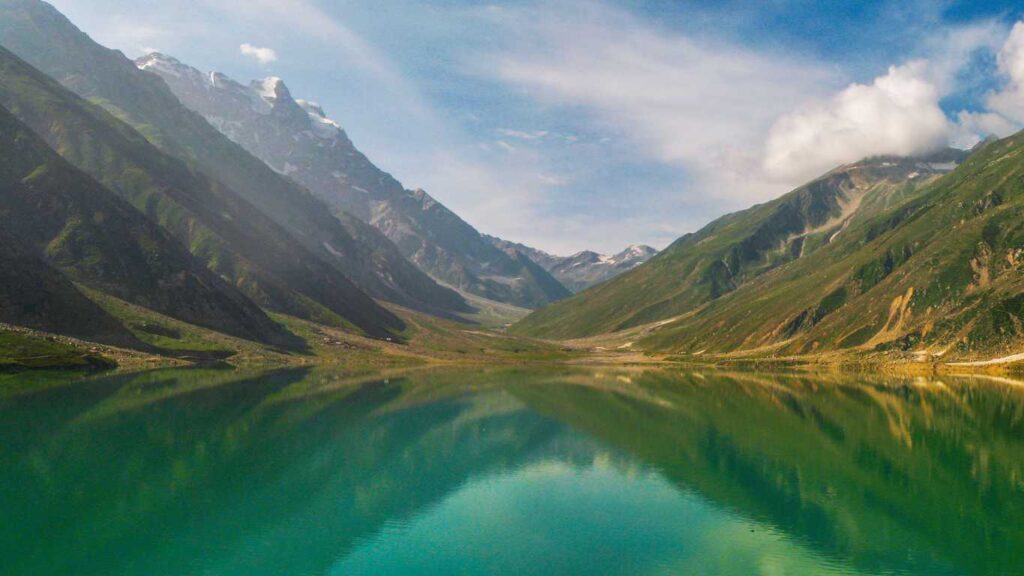
Green Lake Trek
The Green Lake Trek, located in the rugged wilderness of Sikkim, is an exhilarating adventure that leads trekkers to the pristine Green Lake, a high-altitude gem nestled in the heart of the Eastern Himalayas. This trek is celebrated for its challenging terrain, breathtaking vistas, and the chance to witness the towering grandeur of Kanchenjunga, the third-highest peak in the world.
Highlights:
- Green Lake: The trek’s pièce de résistance, Green Lake, is an alpine jewel surrounded by towering peaks and lush meadows, making it an ideal camping site and a surreal spot for stargazing.
- Kanchenjunga Vista: Throughout the journey, soak in awe-inspiring views of Kanchenjunga, Pandim, and other Himalayan giants, providing countless opportunities for mesmerizing photographs.
- Remote Wilderness: Traverse through untamed, remote landscapes, including dense rhododendron forests, glacial moraines, and high-altitude terrains, ensuring a genuine adventure.
- Cultural Encounters: Interact with the local Tibetan and Bhutia communities along the route, offering insights into their rich culture, traditions, and way of life.
- Challenging Terrain: The Green Lake Trek is known for its difficulty, involving steep ascents, rocky trails, and high-altitude camping, making it suitable for experienced trekkers.
Difficulty Level: The Green Lake Trek is considered strenuous and is best suited for trekkers with prior high-altitude trekking experience and excellent physical fitness.
Ideal Duration: Typically spanning 10 to 14 days, this trek allows trekkers to gradually acclimatize to the high altitude and immerse themselves in the mesmerizing landscapes.
Permits and Regulations: Permits are mandatory for this trek, and hiring local guides is essential for safety, route guidance, and adherence to environmental regulations.
Best Time to Trek: The ideal time for the Green Lake Trek is during the pre-monsoon (April to May) and post-monsoon (September to November) seasons when the weather is most favorable, and the landscapes are at their most captivating.
Recommended Itineraries: Most trekkers commence their journey from Lachen and pass through the picturesque villages of Zema and Jakthang before reaching the awe-inspiring Green Lake.
The Green Lake Trek promises a profound exploration of the Eastern Himalayas, where trekkers can immerse themselves in the raw beauty of unspoiled landscapes, relish the serenity of high-altitude lakes, and witness the majesty of some of the world’s tallest peaks. For those who seek a challenging and remote trekking experience in Sikkim, this adventure offers a once-in-a-lifetime opportunity to connect with nature and embrace the Himalayan wilderness at its most pristine.
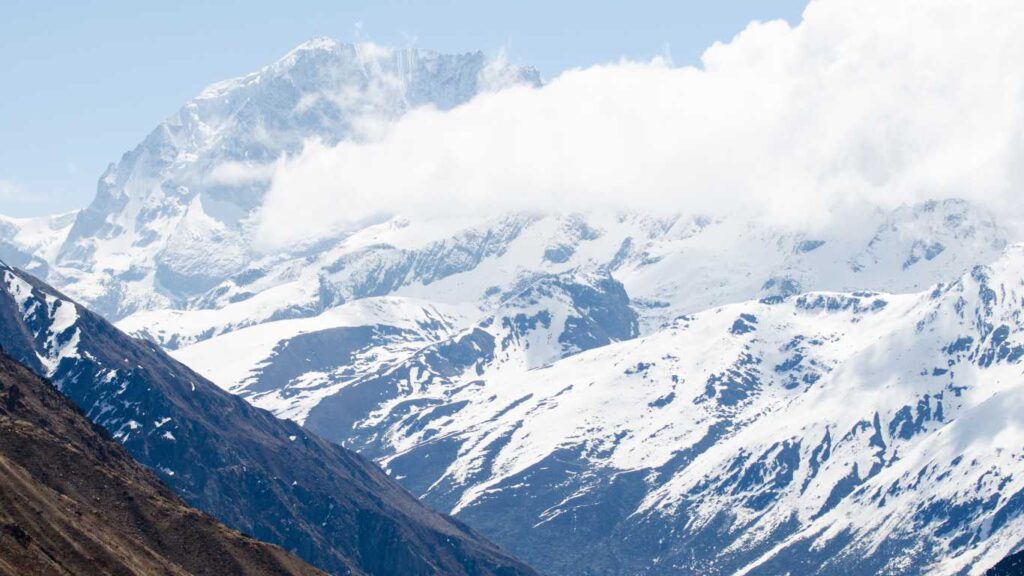
North Sikkim High Altitude Trek
The North Sikkim High Altitude Trek is an extraordinary expedition that takes trekkers into the very heart of the Eastern Himalayas, showcasing some of the region’s most dramatic landscapes, high-altitude lakes, and pristine wilderness. This challenging trek provides a rare opportunity to explore the remote corners of North Sikkim, where the towering peaks and glaciers of the Himalayas dominate the horizon.
Highlights:
- High-Altitude Lakes: The trek offers the chance to visit iconic high-altitude lakes like Gurudongmar Lake and Cholamu Lake, each surrounded by breathtaking mountain vistas.
- Remote Wilderness: Traverse through remote and untouched landscapes, including rugged terrain, glacial moraines, and dense alpine meadows, providing a true wilderness experience.
- Himalayan Peaks: Witness stunning views of towering Himalayan peaks, including Kanchenjunga, as well as other significant summits like Kangchengyao and Simvo.
- Cultural Encounters: Engage with the local Lepcha and Bhutia communities, learning about their unique cultures, traditions, and way of life.
- Challenging Terrain: This trek is highly demanding, with steep ascents and descents, rocky trails, and high-altitude camping, making it suitable only for experienced trekkers.
Difficulty Level: The North Sikkim High Altitude Trek is considered strenuous and is best suited for trekkers with prior high-altitude trekking experience and excellent physical fitness.
Ideal Duration: Typically spanning around 10 to 14 days, this trek allows trekkers to gradually acclimatize to the high altitude and fully immerse themselves in the surroundings.
Permits and Regulations: Trekkers must obtain permits to access these restricted areas, and it’s mandatory to hire experienced local guides who are well-versed in the terrain and environmental regulations.
Best Time to Trek: The ideal time for this trek is during the pre-monsoon (April to May) and post-monsoon (September to November) seasons when the weather is most favorable, and the landscapes are at their most captivating.
Recommended Itineraries: The trek usually starts from Lachen and includes stops at places like Thangu, Chopta Valley, and Gurudongmar Lake, culminating in the mesmerizing landscapes near Cholamu Lake.
The North Sikkim High Altitude Trek is not just an adventure; it’s an expedition to the roof of Sikkim, offering trekkers the opportunity to witness the majesty of the Himalayas in all their grandeur. For those who seek the ultimate high-altitude trekking experience, this challenging journey provides a chance to explore remote wilderness, connect with unique cultures, and create memories that will last a lifetime in the heart of the Eastern Himalayas.
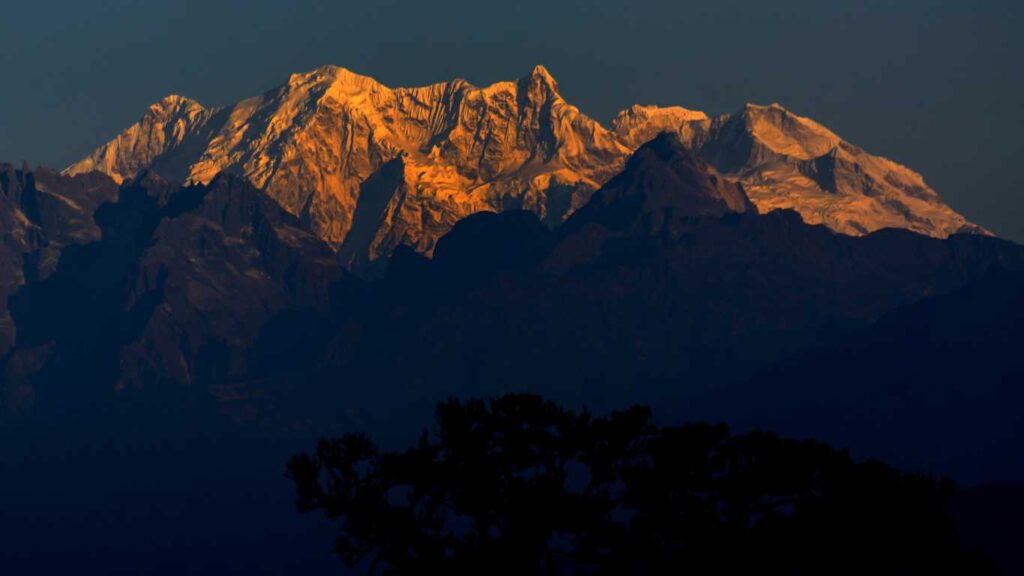
Everest Singalila Trek
The Everest Singalila Trek is an awe-inspiring expedition that showcases the grandeur of the Eastern Himalayas, offering trekkers a unique opportunity to explore both the Nepalese and Indian sides of this stunning mountain range. This trek is renowned for its spectacular vistas, diverse landscapes, and the chance to witness iconic peaks, including the mighty Everest.
Highlights:
- Panoramic Views: Enjoy breathtaking panoramas of some of the world’s highest peaks, including Everest, Lhotse, Makalu, and Kanchenjunga, from vantage points like Sandakphu and Phalut.
- Crossing Borders: Traverse through the borderlands of India and Nepal, immersing yourself in two distinct cultures, and gaining a multifaceted perspective of the Himalayas.
- Diverse Landscapes: Encounter a variety of landscapes, from dense rhododendron forests to alpine meadows, terraced fields, and picturesque villages, each with its unique charm.
- Cultural Immersion: Engage with local communities, including Sherpas, Bhutias, and Gorkhas, to learn about their traditions, lifestyles, and culinary delights.
- Challenging Terrain: The Everest Singalila Trek offers a mix of terrain, with steep ascents, rocky trails, and high-altitude camping, suitable for experienced trekkers.
Difficulty Level: This trek is considered moderate to challenging, making it best suited for trekkers with prior high-altitude trekking experience and a good level of fitness.
Ideal Duration: Typically spanning around 16 to 20 days, this trek allows trekkers to gradually acclimatize to the high altitude and immerse themselves in the Himalayan landscapes.
Permits and Regulations: Permits are required for both the Indian and Nepalese sides of the trek, and hiring local guides is recommended for safety, route guidance, and compliance with regulations.
Best Time to Trek: The ideal time for the Everest Singalila Trek is during the pre-monsoon (April to May) and post-monsoon (September to November) seasons when the weather is most favorable, and the landscapes are at their most captivating.
Recommended Itineraries: The trek typically commences from Manebhanjan in India, leading to Sandakphu and Phalut before crossing into Nepal and continuing through destinations like Tumling and Chitrey on the way to the Everest region.
The Everest Singalila Trek is a true Himalayan odyssey, offering a remarkable blend of cultural immersion and natural grandeur. Trekkers have the rare opportunity to witness the world’s tallest peaks from multiple angles, experience the vibrant cultures of two nations, and explore diverse landscapes, all in a single journey. For those who dream of an unforgettable Himalayan adventure, this trek provides a once-in-a-lifetime experience.
Preparation and Planning for Trekking in Sikkim
Trekking in Sikkim demands thorough preparation and planning to ensure a safe and enjoyable adventure amidst the Himalayas. Here’s a comprehensive guide to help you get ready:
Physical Fitness and Health:
- Assess Your Fitness: Gauge your physical fitness and endurance levels, as Sikkim’s treks can be physically demanding. Regular cardio and strength exercises can help prepare your body.
- Consult a Doctor: Visit a healthcare professional for a thorough check-up, especially if you have any underlying health conditions. Discuss vaccinations and altitude-related concerns.
What To Pack For Trekking In Sikkim
Packing for a trek in Sikkim requires careful consideration of the region’s diverse terrain and varying weather conditions. Here’s a comprehensive packing list to ensure you have everything you need for a successful and comfortable trek:
- Clothing: Layer your clothing for varying temperatures. Include moisture-wicking base layers, insulated jackets, waterproofs, and comfortable trekking pants. Don’t forget extra socks and underwear.
- Footwear: Invest in sturdy, waterproof trekking boots with good ankle support. Break them in before your trek.
- Backpack: Choose a comfortable and appropriately-sized backpack with adjustable straps to distribute weight evenly.
- Sleeping Bag: Opt for a quality, cold-rated sleeping bag suitable for the trek’s expected temperature range.
- Trekking Poles: Consider using trekking poles to aid balance and reduce strain on your knees.
- Headlamp/Flashlight: Ensure you have a reliable source of light with extra batteries.
- Hydration System: Carry a reusable water bottle and water purification tablets or a filter.
- Navigation Tools: Maps, compass, and GPS device are essential for navigation, especially in remote areas.
- First-Aid Kit: Assemble a comprehensive first-aid kit, including medications for altitude sickness, blisters, and other common trekking ailments.
- Toiletries: Pack travel-sized toiletries, a quick-drying towel, and biodegradable soap.
- Documents: Keep photocopies of essential documents (ID, permits, insurance) in a waterproof bag.
Hiring Local Guides and Porters:
- Local Knowledge: Consider hiring experienced local guides who know the terrain, weather patterns, and culture. They can enhance your trekking experience and ensure safety.
- Porters: If you’re carrying heavy gear or need extra assistance, hire porters to lighten your load. It supports the local economy and eases your journey.
4. Booking Accommodations and Permits:
- Accommodations: Book guesthouses or lodges in advance, especially during peak trekking seasons, to ensure availability.
- Permits: Obtain the necessary permits from the Sikkim Tourism Department for your chosen trekking routes. Check the latest permit regulations and application procedures.
5. Travel Insurance and Permits:
- Insurance: Purchase comprehensive travel insurance covering medical emergencies, evacuation, and trip cancellations. Confirm that it includes high-altitude trekking.
- Permits: Ensure all required permits are in order and carry both physical and digital copies.
6. Altitude Sickness Precautions:
- Acclimatization: Plan your itinerary to include gradual altitude gains and acclimatization days. Listen to your body and descend if you experience severe symptoms.
- Stay Hydrated: Drink plenty of water to combat altitude sickness. Avoid alcohol and caffeine.
- Medications: Carry medications like Diamox as a precaution and know how to use them.
Preparation and planning are crucial to a successful and safe trek in Sikkim. Taking the time to get physically fit, assemble the right gear, and understand the logistics of your journey will ensure you’re well-prepared to embrace the beauty and challenges of this Himalayan paradise.

Cultural and Natural Highlights
Trekking in Sikkim offers not only pristine natural beauty but also a rich tapestry of cultural diversity. Here, we delve into the cultural and natural highlights you can encounter during your trekking adventure:
Cultural Highlights:
- Local Communities: Sikkim is home to a fascinating mix of ethnic communities, including the Bhutias, Lepchas, Nepalis, and Tibetans. Each group has its unique traditions, language, and cuisine, offering trekkers a diverse cultural experience.
- Monasteries and Gompas: Along many trekking routes, you’ll come across ancient monasteries and gompas that provide insight into Sikkim’s spiritual heritage. The Enchey Monastery in Gangtok and the Tashiding Monastery near Yuksom are just a couple of notable examples.
- Festivals: If your trekking dates align with local festivals, you’re in for a treat. Festivals like Losar (Tibetan New Year) and Dashain (a Hindu festival) offer vibrant displays of traditional dance, music, and rituals.
- Local Cuisine: Taste the flavors of Sikkim through its diverse cuisine. Momos (dumplings), Thukpa (noodle soup), and Phagshapa (pork stew) are local delicacies you might encounter during your trek.
- Traditional Dress: Observing locals in their traditional attire, such as the Bhutia’s Kho, is a cultural immersion in itself. You might even have the opportunity to try on these beautiful garments.
Natural Highlights:
- Biodiversity: Sikkim is renowned for its rich biodiversity, including numerous species of flora and fauna. Keep an eye out for the elusive Red Panda, various species of orchids, rhododendrons, and a wide range of birdlife.
- Rhododendron Forests: If you trek during spring, Sikkim’s rhododendron forests burst into a riot of colors, with vibrant blooms covering the landscape. It’s a sight to behold and a dream for nature photographers.
- High-Altitude Lakes: Treks like the Goechala and Dzongri often lead you to serene high-altitude lakes, such as Samiti Lake and Dzongri Lake, which reflect the surrounding peaks like mirrors.
- Alpine Meadows: As you ascend higher, you’ll encounter lush alpine meadows, like those at Dzongri, adorned with wildflowers and surrounded by towering peaks.
- Mountain Vistas: Sikkim’s treks offer some of the world’s most iconic mountain views. Whether it’s the sunrise over Kanchenjunga from Tiger Hill or the panorama of Everest and Makalu from Sandakphu, these vistas are unforgettable.
- Clear Skies and Starry Nights: Due to its remote locations, Sikkim often provides crystal-clear skies, perfect for stargazing. The lack of light pollution makes for a breathtaking celestial display.
- River Crossings: Many treks involve crossing pristine rivers and streams, providing opportunities to enjoy the tranquility of nature and refreshing dips.
- Sacred Sites: Sikkim is dotted with sacred sites like the Tashiding Monastery and Gauri Kund, believed to have spiritual significance. These places offer moments of serenity and reflection.
Trekking in Sikkim isn’t just about conquering peaks; it’s about immersing yourself in a world of cultural diversity and natural splendor. As you journey through this Himalayan wonderland, take the time to appreciate the unique blend of cultures and the breathtaking beauty that surrounds you at every turn.
Safety and Health
Trekking in Sikkim’s Himalayan terrain is a thrilling adventure, but it comes with its own set of challenges and potential health risks. Ensuring safety and maintaining good health during your trek is paramount. Here are essential safety and health considerations:
1. Altitude Sickness Prevention and Management:
- Acclimatization: Plan your trek itinerary to include gradual altitude gains and acclimatization days at higher elevations. Ascend slowly to allow your body to adjust to lower oxygen levels.
- Stay Hydrated: Drink plenty of fluids to combat dehydration, a common issue at high altitudes. Avoid alcohol and caffeine.
- Medications: Carry medications like Acetazolamide (Diamox) as a preventive measure against altitude sickness. Consult a doctor before using them.
- Recognize Symptoms: Be vigilant for symptoms of altitude sickness, including headaches, nausea, dizziness, and fatigue. If you experience severe symptoms, descend immediately.
2. Emergency Contacts and Communication:
- Local Contacts: Keep a list of local emergency contacts and know the locations of nearby medical facilities.
- Communication: Carry a satellite phone or an emergency beacon (like a Personal Locator Beacon) for remote areas with no cell signal. Inform someone of your trekking plans and expected return dates.
3. First-Aid and Medical Facilities:
- First-Aid Kit: Assemble a comprehensive first-aid kit that includes essentials like bandages, antiseptics, blister treatment, pain relievers, and any personal medications.
- Medical Facilities: Research the availability of medical facilities along your trekking route. Larger towns like Yuksom and Gangtok have clinics and hospitals.
4. Safe Food and Water Practices:
- Water Purification: Carry a reliable water purification method (iodine tablets, filters, or UV purifiers) to ensure safe drinking water. Avoid tap water and untreated water sources.
- Food Hygiene: Eat at reputable teahouses and lodges. Wash your hands frequently and use hand sanitizer before meals. Avoid raw or undercooked foods.
5. Clothing and Gear:
- Layering: Dress in layers to regulate your body temperature. Be prepared for changing weather conditions by carrying waterproof and windproof clothing.
- Footwear: Ensure your trekking boots are comfortable, well-fitted, and appropriate for the terrain. Break them in before your trek to prevent blisters.
- Trekking Poles: Use trekking poles for stability and to reduce the strain on your knees, especially during descents.
6. High-Altitude Considerations:
- Hypothermia: Be aware of the risk of hypothermia, even in the warmer seasons. Carry extra layers, a warm hat, and gloves.
- Sun Protection: At higher altitudes, the sun’s UV rays are stronger. Use sunscreen, wear sunglasses, and use lip balm with sunblock to protect your skin.
7. Group vs. Solo Trekking:
- Trekking in Groups: It’s generally safer to trek in groups, as you can support each other in case of emergencies or accidents. Groups also deter wildlife encounters.
8. Emergency Evacuation Plans:
- Insurance: Ensure you have comprehensive travel insurance that covers emergency evacuation by helicopter if needed.
- Emergency Protocol: Familiarize yourself with the emergency evacuation procedures in the region. In case of an emergency, stay calm and follow established protocols.
Prioritizing safety and health during your Sikkim trek is essential to enjoy a memorable and incident-free adventure. Preparedness, acclimatization, and adherence to safety guidelines will help you make the most of your trekking experience in this breathtaking Himalayan region.

Transport Around Sikkim
Transportation in Sikkim can be both challenging and exciting due to its mountainous terrain and remote locations. Here’s an overview of the various transportation options available for getting around in Sikkim:
- Local Taxis: Local taxis, often Maruti Suzuki Alto cars, are a common mode of transportation within Sikkim. These taxis can be hired for short trips within cities like Gangtok or for longer journeys to nearby destinations. Negotiate fares in advance or use the fare meter if available.
- Shared Taxis: Shared taxis are a cost-effective way to travel between towns and cities in Sikkim. They follow specific routes and pick up passengers along the way until the vehicle is full. This option is budget-friendly but may not offer much privacy.
- Private Car Rentals: Renting a private car with a driver is a convenient option for exploring Sikkim, especially if you want more flexibility in your itinerary. Rental agencies can be found in major towns like Gangtok and offer various vehicle types, including SUVs for mountainous terrain.
- Jeep Safaris: For off-road adventures and accessing remote areas like Yumthang Valley, Gurudongmar Lake, or Dzongri, consider hiring a sturdy 4×4 vehicle. Jeep safaris are often arranged by local tour operators and provide a thrilling way to explore rugged terrains.
- Buses: Sikkim State Transport (SNT) operates a network of buses that connect major towns and cities within the state. While buses are cost-effective, they might not be the most comfortable option, especially for long journeys on winding mountain roads.
- Shared Sumos: Shared Sumos (larger passenger vehicles) are commonly used for inter-city transportation in Sikkim. They are more spacious than shared taxis and provide a reasonably comfortable mode of travel between towns.
- Helicopter Services: Sikkim offers helicopter services that provide a quick and scenic way to reach remote areas. This mode of transportation is ideal for those with a higher budget and limited time.
- Treks and Hikes: In certain areas of Sikkim, especially remote and high-altitude regions, trekking and hiking are the primary means of getting around. Treks like the Goechala Trek and Kanchenjunga Base Camp Trek involve walking through picturesque trails.
- Local Ferries: In some areas near rivers and lakes, you may find local ferries or boats that offer a unique way to travel short distances.
- Cable Cars and Ropeways: Some cities in Sikkim, like Gangtok, have cable cars and ropeway services that provide panoramic views of the surrounding landscapes while transporting you to higher altitudes.
It’s essential to plan your transportation in advance, especially if you’re traveling during peak tourist seasons. Additionally, road conditions can vary, so be prepared for slower travel times, particularly in hilly and mountainous regions. Always check local regulations, road conditions, and permit requirements before embarking on your journey in Sikkim.
Trekking Tips and Etiquette
Trekking in Sikkim not only offers breathtaking natural beauty but also allows you to interact with local communities and immerse yourself in the unique culture of the region. Adhering to trekking tips and etiquette is not only respectful but also enhances your overall experience. Here’s a guide to help you navigate these aspects:
1. Leave No Trace Principles:
- Pack Out What You Pack In: Ensure you carry all your trash and dispose of it properly. Leave nature as you found it.
- Camp Responsibly: Use designated campsites when available. If not, camp at least 200 feet away from lakes and streams to protect fragile ecosystems.
- Respect Wildlife: Observe animals from a distance, avoid feeding them, and do not disturb their habitats.
2. Respect for Local Customs and Environment:
- Cultural Respect: Learn about and respect the local customs, traditions, and religious practices. Ask for permission before entering monasteries and sacred sites.
- Environmental Respect: Stay on marked trails to prevent damage to fragile ecosystems. Do not pick plants or disturb wildlife. Avoid loud noises and music that can disrupt the tranquility of the environment.
3. Trekking in Groups vs. Solo:
- Safety in Numbers: Trekking in a group enhances safety, especially in remote areas. It’s easier to seek help or assistance if needed.
- Solo Trekking: If you prefer to trek solo, inform someone about your plans and expected return. Carry communication devices like a satellite phone or locator beacon.
4. Dealing with Unexpected Challenges:
- Weather: Be prepared for changing weather conditions. Carry waterproof clothing and extra layers. It’s advisable to check weather forecasts regularly.
- Navigation: Familiarize yourself with maps and navigation tools. Always inform someone of your intended route and estimated return time.
- Altitude Sickness: Recognize the symptoms of altitude sickness and be willing to descend if you or a fellow trekker experiences severe symptoms.
5. Responsible Photography:
- Respect Privacy: Ask for permission before taking photos of local people. Some communities may prefer not to be photographed.
- Wildlife Photography: Use long lenses to capture wildlife from a distance without disturbing them. Avoid using flash, which can stress animals.
6. Waste Management:
- Carry Waste Bags: Pack your trash in waste bags and carry them back to proper disposal facilities. Do not burn or bury trash.
7. Trail Etiquette:
- Yielding the Trail: Yield the trail to ascending hikers. Uphill hikers have the right of way.
- Quiet Zones: Some areas may have designated quiet zones near monasteries or religious sites. Maintain silence in these areas.
8. Interaction with Locals:
- Respect Privacy: Approach local homes and villages with respect and discretion. Always seek permission before entering private properties.
- Cultural Exchange: Engage with locals with genuine curiosity and respect. Learn about their traditions and lifestyles and share your own experiences.
By following these trekking tips and practicing proper etiquette, you’ll not only contribute to the preservation of the environment and culture but also have a more enriching and respectful trekking experience in Sikkim.
Trekking Costs and Budgeting in Sikkim
Trekking in Sikkim can be an unforgettable adventure, but it’s essential to plan your budget carefully to ensure a memorable and financially sustainable journey. Here’s a guide to help you estimate the costs and budget effectively:
1. Permit Costs:
- Sikkim requires trekkers to obtain permits for specific trekking routes. Permit fees vary based on the route and nationality.
- It’s advisable to check the latest permit fees and regulations with the Sikkim Tourism Department before your trek.
2. Guide and Porter Fees:
- Hiring a local guide is not mandatory but highly recommended for safety and cultural insights. Guide fees vary depending on the trek and duration.
- Porters can be hired to carry your heavy gear. Their fees are based on the weight of the load.
- Negotiate guide and porter fees in advance, and clarify what services are included.
3. Accommodation Costs:
- Sikkim offers a range of accommodation options, from basic teahouses to more comfortable lodges. Prices vary accordingly.
- During peak trekking seasons, it’s advisable to book accommodations in advance, which can help secure better rates.
4. Food Expenses:
- Meals are typically available at teahouses and lodges along trekking routes. Costs can vary, with more remote areas often being more expensive.
- Budget for three meals a day, snacks, and beverages.
5. Transportation Costs:
- Getting to and from Sikkim is a significant expense. Consider the cost of flights or train tickets to your entry point (e.g., Bagdogra Airport, New Jalpaiguri Railway Station).
- Local transportation within Sikkim, such as taxis or shared vehicles to trailheads, should also be factored into your budget.
6. Gear and Equipment:
- If you don’t have your own trekking gear, you may need to rent or purchase items such as trekking boots, backpacks, and sleeping bags. Budget accordingly.
- High-quality gear is essential for comfort and safety, so consider investing in suitable equipment.
7. Travel Insurance:
- Comprehensive travel insurance is a must, covering medical emergencies, evacuation, and trip cancellations. Be sure to include high-altitude trekking in your coverage.
8. Miscellaneous Expenses:
- Budget for unexpected expenses, such as permits for photography or videography, emergency medical expenses, and souvenirs.
9. Currency and Payment Methods:
- The local currency in Sikkim is the Indian Rupee (INR). Carry enough cash, as ATMs may be limited in remote areas.
- Credit cards are not widely accepted in rural areas, so cash is essential.
10. Budgeting Tips:
- Plan a daily budget based on your trek’s expected duration and route.
- Keep some extra cash in reserve for emergencies or unexpected expenses.
- Share costs with trekking companions when possible, such as guide and porter fees.
- Research and compare prices for accommodations and services to find the best deals.
It’s crucial to budget realistically and plan for potential contingencies during your trekking adventure in Sikkim. By carefully estimating your costs and ensuring that you have the necessary funds available, you can fully enjoy the natural beauty and cultural richness that this Himalayan region has to offer.
Post-Trek Activities
After an exhilarating trek through the stunning landscapes of Sikkim, it’s time to unwind and explore more of what this Himalayan state has to offer. Here are some post-trek activities to make the most of your visit to Sikkim:
1. Relax in Hot Springs:
- Sikkim is blessed with natural hot springs known for their therapeutic properties. Popular ones include Yumthang Hot Springs and Reshi Hot Springs. Soak in the warm waters and rejuvenate your tired muscles.
2. Explore Sikkim’s Capital – Gangtok:
- Head to Gangtok, the capital of Sikkim, to immerse yourself in its vibrant culture and bustling markets. Visit the Enchey Monastery, Hanuman Tok, and the Namgyal Institute of Tibetology for cultural insights.
3. Visit Historical Sites:
- Explore historical sites like Rabdentse Ruins, the capital of the former Kingdom of Sikkim, and the Norbugang Chorten, where the first Chogyal (Sikkimese king) was consecrated.
4. Witness the Himalayan Sunrise:
- Wake up early to witness the mesmerizing sunrise from Tashi Viewpoint or Ganesh Tok. The view of the first rays of sunlight touching the Himalayan peaks is a sight to behold.
5. Discover Sikkim’s Cuisine:
- Savor Sikkimese cuisine at local restaurants. Don’t miss trying momos, thukpa, and other regional delicacies. Sikkim is known for its diverse culinary offerings.
6. Visit Tsomgo Lake and Baba Mandir:
- Take a day trip to Tsomgo Lake and the Baba Harbhajan Singh Temple. The pristine lake surrounded by mountains and the temple’s history makes for an interesting excursion.
7. Explore Sikkim’s Botanical Gardens:
- Visit the Jawaharlal Nehru Botanical Garden in Rumtek, which houses a wide variety of Himalayan flora and fauna. It’s a great place for nature enthusiasts and photographers.
8. Go Shopping:
- Explore the local markets in Gangtok and other towns to shop for souvenirs like handicrafts, traditional attire, and local spices.
9. Birdwatching and Wildlife Tours:
- Sikkim is home to diverse bird species and wildlife. Consider taking a guided birdwatching tour or visiting wildlife sanctuaries like the Fambong Lho Wildlife Sanctuary.
10. Yoga and Meditation Retreats:
- Sikkim offers serene settings for yoga and meditation retreats. Join one to unwind and connect with your inner self amidst the Himalayan tranquility.
11. Learn about Local Handicrafts:
- Visit local workshops to see artisans creating intricate handicrafts and traditional thangka paintings. You can even try your hand at some of these crafts.
12. Plan Your Next Adventure:
- Use your post-trek relaxation time to plan your next adventure in Sikkim or neighboring regions, like Bhutan or Nepal. Sikkim is an excellent base for further exploration.
Whether you choose to unwind in hot springs, delve into the local culture, or embark on new adventures, Sikkim offers a diverse range of post-trek activities to suit every traveler’s interests and preferences. Make the most of your time in this Himalayan gem by immersing yourself in its beauty and rich heritage.
Conclusion
Trekking in Sikkim is an extraordinary journey that blends the pristine beauty of the Himalayas with a rich tapestry of cultures and traditions. From the towering peaks and lush alpine meadows to the warm hospitality of local communities, Sikkim offers a transformative experience for adventurers. It’s a place where nature’s grandeur meets human warmth, where the challenges of the trails are rewarded with breathtaking vistas and cultural enrichment. As you bid farewell to this Himalayan wonderland, you carry not just memories but a profound connection to the mountains, leaving you with a yearning to return and explore more of Sikkim’s enchanting treasures.
Frequently Asked Questions (FAQ) About Trekking in Sikkim
What is the best time to go trekking in Sikkim?
The ideal time for trekking in Sikkim is during the pre-monsoon (April to May) and post-monsoon (September to November) seasons. During these periods, the weather is relatively stable, and the landscapes are at their most stunning, with clear skies and vibrant flora.
Do I need permits for trekking in Sikkim, and how can I obtain them?
Yes, permits are required for trekking in Sikkim. You can obtain these permits from the Sikkim Tourism Department or through registered tour operators. The process usually involves providing necessary documents, such as identification, and paying the requisite fees.
Is it necessary to hire a guide for trekking in Sikkim?
While it’s not mandatory, hiring a local guide is highly recommended. Local guides have valuable knowledge of the terrain, weather conditions, and cultural insights. They enhance your safety and provide a deeper understanding of the region.
What trekking routes are suitable for beginners in Sikkim?
Sikkim offers various trekking routes suitable for beginners, such as the Dzongri Trek and the Yuksom to Tshoka Trek. These routes offer moderate difficulty levels and provide opportunities for acclimatization.
How can I prepare for high-altitude trekking and prevent altitude sickness in Sikkim?
Preparing for high-altitude trekking involves gradual acclimatization, staying well-hydrated, and being aware of the symptoms of altitude sickness. It’s advisable to consult a doctor before the trek and carry necessary medications like Diamox. Ascend slowly, take acclimatization days, and descend if you experience severe symptoms.

